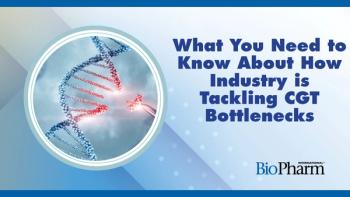
- BioPharm International, November-December 2024
- Volume 37
- Issue 10
- Pages: 14–17, 29
Synthetic DNA as an Alternative to Plasmids
Synthesis of DNA via cell-free methods has many benefits versus fermentation.
The rapid advance of next-generation therapies, such as gene and gene-modified cell therapies and messenger RNA (mRNA)-based vaccines, through the clinical phase to market has created significantly increased demand for DNA raw materials. Plasmid DNA (pDNA) produced via fermentation in Escherichia coli (E. coli) is typically used, but supply has struggled to keep up with demand. “The need for DNA in genetic medicine won’t be met using cell-based cloning from the 1970s and DNA synthesis technologies from the 1980s deployed in massive DNA factories,” says Randy Dyer, vice-president of marketing at Elegen. “Advanced technologies, with higher-throughput and smaller footprints that replace fickle cells with more repeatable in-vitro approaches, are likely the answer to the growing need to iterate fast in R&D and transition to clinical in a fraction of the time it takes today.”
Rising DNA Demand
The COVID-19 pandemic created substantially greater demand for DNA used for both research and clinical applications, and demand continues to grow given the expanding interest in RNA-based therapies and vaccines, genetic medicines, cell-free protein synthesis, DNA origami, and other uses, according to Ashish Dhir, head of RNA at 4basebio. One estimate sees global demand for DNA rising from 3 kilograms per year to anywhere from 10 to 100 kilograms annually, a three- to 30-fold increase (1). The value of the global pDNA market was estimated to be expanding at a compound annual growth rate of 21.05% from $1.83 billion in 2023 to $12.36 billion by 2033, 87% of which is thought to be good manufacturing practice (GMP)-grade for clinical and commercial production (2).
Capacity for pDNA was tight prior to the pandemic, and although significant investments in additional capacity have been made in recent years, access to high-quality pDNA raw material for GMP production remains challenging.
Plasmid DNA Manufacturing and Supply Issues
One of the main reasons pDNA supply is limited relates to the critical shortcomings in pDNA manufacturing processes, according to Lisa Caproni, associate director of applications with Touchlight.
E. coli cell-based fermentation is the traditional method for scaling up the production of DNA for pre-/clinical use, but it is labor-intensive, time-consuming, and expensive with variable outcomes in the manufacturing process, adds Dyer.
The bacterial fermentation process itself, which is derived from a master cell bank (MCB), is hampered by lengthy production times and complex downstream purification, comments Caproni. In addition, she notes that expanding pDNA capacity requires securing additional large manufacturing footprints to accommodate large-scale production, with significant capital expenditure for stainless-steel fermenters and chromatography columns. “The significant monetary and business commitment needed to increase capacity means this is not a trivial decision and represents a barrier to fast, agile responsiveness in face of changing or uneven demand,” says Caproni.
“pDNA ready for cell-based fermentation is only obtained after small, error-prone synthetic DNA fragments are assembled and cloned in bacteria. Bacterial colonies are then grown and sequenced to identify the sequence-perfect clone, which is then expanded in a fermentation tank to produce a larger quantity. MCBs require six to 12 months of careful process development and characterization with intensive process monitoring and GMP-based quality control, with costs ranging from $500,000 to millions of dollars depending on batch size,” Dyer says.
In addition to involving a substantial footprint, production of plasmid DNA in large bioreactors is often hindered with low yields, including batch failures, owing to the complexity and nature of upstream and downstream operations and resulting in high costs and long lead times, adds Amy Walker, the COO of 4basebio. “With limited large-scale, GMP production capacity and high demands, lead times for GMP plasmid DNA can extend to many months or more,” she remarks.
With fermentation-based pDNA production, there is also the risk of carrying through bacterial cell components from E. coli fermentation, including bacterial genomic DNA (e.g., antibiotic resistance genes and other bacterial sequences that enable production of E. coli) and endotoxins, according to Caproni. In addition, she notes that scalability of pDNA manufacturing is constrained by the yield and purity challenges inherent in the fermentation process. “The real challenge,” she contends, “is not adding capacity, but minimizing cost of goods sold (COGS) while maintaining the necessary quality standards in these complex processes at scale.”
Furthermore, certain genetic sequences, including some of those required for adeno-associated virus (AAV) vectors and mRNA production, such as inverted terminal repeats (ITRs) and homopolymeric regions, are genetically unstable or toxic to E. coli, resulting in production of heterogenous populations of pDNA and/or very low yield, which can become an increasingly significant issue on scale up of production, Caproni notes.
Synthetic DNA manufacturing advantages
Production of DNA using chemical or enzymatic methods in a cell-free environment avoids many of the problems inherent in fermentation-based manufacturing of pDNA. “Synthetic DNA produced entirely cell-free completely circumvents cell-based cloning and the need for MCBs, as well as all the associated labor, time, and expense,” explains Dyer.
Specific advantages, according to Walker, include high yields, simpler purification, no concern about bacterial or antibiotic resistance genes, reduced risk of residual host-DNA and endotoxin impurities, and a smaller footprint allowing scale flexibility with efficiency and speed. Enzymatic DNA production, adds Caproni, also affords the ability to target genes with a size and complexity that is impossible with current technologies, enabling the manufacturing of DNA in a faster, simpler, and more cost-effective manner.
Synthetic DNA can also be produced in a linear open or closed format depending on the needs of the intended application. For instance, access to a linear open format is a distinct advantage over pDNA for mRNA applications, as the linearization of the DNA is not required. In addition, it is possible to include longer poly(A) tails while excluding unnecessary genetic material in synthetic pDNA, leading to higher transcription yields of more stable mRNAs over pDNA, according to Dhir.
One of the challenges to enzymatic production of DNA in the past was the higher error rate observed when using conventional polymerases than is realized with bacterial amplification systems (3). Enzymes used today have been designed and engineered to overcome this problem, enabling production of synthetic DNA with high fidelity.
Highlighting synthetic DNA products
4basebio’s synthetic DNA is produced using a fully enzymatic cell-free amplification process. In addition to the benefits described previously, it overcomes recombination issues with complex sequences such as homopolymeric tracts, ITRs, and sequences that are generally toxic to bacteria, according to Dhir. “We offer reduced lead times for GMP-quality DNA typically on average of several months to a year for pDNA to [eight to] 12 weeks for synthetic DNA, or faster in the case of a personalized cancer vaccine,” he says. The company offers four customizable, application-specific double-stranded DNA (dsDNA) templates designed specifically for mRNA, AAV, and lentivirus (LV) production, as well as gene-editing and other applications, and can produce microgram to multigram batches using its scalable enzymatic process, adds Walker.
Doggybone DNA (dbDNA) from Touchlight is also produced enzymatically. It is a minimal, linear, covalently closed structure with no bacterial sequences that has a natural inbuilt copy number advantage, which, according to Caproni, is attractive in a market that sells DNA by the milligram or gram. In addition, dbDNA processes run at less than 5-L scales produce equivalent yields to those obtained for fermentation batches of more than 50 L, and even up to 300 L, according to Caproni. “Our GMP suites are less than 20 m2 and accommodate both upstream DNA amplification and the downstream purification within this small space, using simple benchtop equipment and no requirement for piped water, waste, or steam. This scale of operations is a step-change improvement to technologies based on bacterial fermentation,” she states.
Touchlight also currently offers two other DNA molecules designed specifically for mRNA production and gene editing applications and is developing other, newer DNA formats targeting improved functionality, Caproni notes.
Elegen’s DNA product (ENFINIA DNA) is differentiated, says Dyer, because it is not made using a pDNA template, but produced in an entirely cell-free process leveraging innovations in molecular biology, chemistry, and microfluidics that address length, complexity, accuracy, purity, and scalability. Its linear dsDNA can be generated in lengths up to 7 kilobases with high complexity (e.g., ITRs, long-terminal repeats, guanine- and cytosine-rich elements, enhancers, terminators, and long homopolymers), low error rates, and next-generation-sequencing-verified accuracy in six to eight business days, he comments. “With such rapid access to highly accurate and complex DNA, genetic medicine developers can shave as much as 15 weeks off their development timelines,” states Dyer.
Caproni notes that, because Touchlight believes the fidelity of long synthesized DNA is not yet sufficient for use directly as a template, its plug-and-play process including GMP production still begins with a pDNA template. “This space is evolving, however, and we have active programs driving towards entirely bacteria-free template provision and will deliver these offers when the technology and time are right. This switch requires not just the development of synthesized template production, but conversations with regulatory authorities to reassure that making this switch does not detrimentally impact overall quality. Many of our clients have active clinical programs, so we take great care in ensuring we provide material of the highest quality and fidelity,” she states.
Multiple grades
Synthetic DNA is broadly used and available as research grade or GMP grade; although, some suppliers such as 4basebio and Touchlight offer additional intermediate grades suited for good laboratory practice tox or investigational new drug (IND) application-enabling studies.
“As with GMP-grade pDNA, GMP-grade synthetic DNA is manufactured in a highly controlled, sterile environment following GMP guidelines to ensure the quality, purity, and consistency of the DNA, making it suitable for clinical trials and therapeutic use in humans,” Dyer comments. Similarly, synthetic DNA GMP processes require extensive documentation to ensure full traceability of materials, procedures, and equipment used. Research-grade DNA is produced under standard laboratory conditions without stringent quality assurance of production processes or the above extensive documentation and is intended for use in research and non-human applications.
Synthetic DNA performance advantages
In addition to simpler and more cost-effective manufacturing processes, synthetic DNA also provides performance advantages in many different applications. Simpler regulatory reviews are one example. “Consider the contrast between viral therapies relying on pDNA from cell-based cloning, which often require full FDA reviews due to their complexity and variability, and mRNA vaccine platforms using cell-free DNA production. The latter can leverage existing data, bypassing certain regulatory hurdles and streamlining approval processes,” Dyer observes.
Furthermore, due to lack of any extraneous sequence, synthetic linear double stranded DNA contains exclusively the therapeutically relevant functional gene of interest, Dhir says. “This attribute offers wide benefits in both packaging of DNA in AAV vectors or non-viral vectors, with feasibility to add multiple coding sequences on one linear DNA that is often limited in a plasmid setting due to the undesired backbone.”
It is also possible to design synthetic DNA to meet the specific needs of different applications. 4basebio, for instance, offers application-specific DNA products suited for viral-vector production (hpDNA), in-vitro transcription (IVT) to generate mRNA (opDNA), and gene editing (oeDNA, ssDNA). The opDNA is linear with an open 3’ end suited for IVT, eliminating the need for the linearization step required for pDNA, while the hpDNA presents no risk of reverse packaging combined with enhanced size flexibility in accommodating therapeutic genes, according to Dhir.
Touchlight’s dbDNA has demonstrated dose sparing compared to pDNA when used in DNA vaccines and non-viral gene therapy delivered by multiple routes and methods, Caproni observes. For viral-vector production, she notes that it generates equivalent titers for AAV and lentiviral vectors using less DNA and transfection reagent, also with improved full:empty viral-particle ratios for AAV vectors. Less dbDNA is also needed in IVT reactions for the manufacture of RNA with the added benefit of improved IVT yields and rapid production of high-fidelity product. In gene editing, Caproni observes that dbDNA regularly outperforms pDNA for gene-length knock-ins.
These benefits are mainly attributed to size and copy number advantages due to the absence of extraneous DNA, an inherent benefit of synthetic DNA in general, as emphasized by 4basebio with its application-specific DNA products, according to Dhir. “This dose sparing confers cost saving benefits to clients,” he notes.
In addition to dbDNA, Touchlight also offers zdbDNA for mRNA production, which is open at the 3’ end and shows reduced template requirements and improved IVT yields, and megabulb DNA (mbDNA), a single-stranded closed circular DNA with increased efficiency and reduced toxicity in primary cell editing compared to classic dsDNA and single-stranded open molecules, according to Caproni.
Already in the clinic
Synthetic DNA is a nascent yet rapidly growing field with various company platforms that offer ever-developing novel products with unique features and applications. In 2023, FDA cleared the first IND application for a therapeutic produced using dbDNA and accepted Touchlight’s drug master file (DMF) for GMP-grade dbDNA.
Currently there are a total of three therapies produced with dbDNA in the clinic in the United States and Europe, and multiple additional clinical projects that have initiated regulatory engagement (4,5). Touchlight further expects to manufacture dbDNA for a pivotal study later in 2024, according to Caproni. “These programs, which comprise AAV, mRNA, DNA vaccine, and gene editing applications, reflect the transformative nature of dbDNA to improve the viability, economics, and safety of scaling advanced therapies,” she contends.
4basebio in 2024 is supporting two publicly disclosed clients manufacturing clinical-grade mRNA using synthetic opDNA as the starting template. One has entered the clinic and dosed more than 30 patients, while the other is preparing to file its IND application, according to Walker. Meanwhile, a European-based DNA vaccine company is anticipated to use hpDNA as a drug substance in the first half of 2025. Further clients are engaged with regulators in multiple jurisdictions and poised for clinical trials throughout 2025.
GMP supply increasing
“Progress in the manufacture of large quantities of DNA for use in the production of therapeutics, vaccines, and diagnostics cannot be underestimated,” Dhir states. “Therapies produced using synthetic DNA have begun to enter the clinic. While the space remains nascent, the benefits of cell-free DNA, from time and cost savings to smaller footprints and greater sustainability, along with the application-specific benefits of tailored synthetic DNA molecules, has the potential to drive the biopharma industry away from cell-based manufacturing—not just for plasmids, but proteins and other biomolecules as well,” he adds.
Manufacturing capacity for synthetic DNA is also increasing. 4basebio currently has seven GMP cleanroom manufacturing suites, with the possibility of manufacturing GMP batch sizes ranging from 50 mg to 10 grams, and is well positioned to support its clients though clinical trials. Due to the nature of the enzymatic process, Walker says it is highly scalable and amenable to additional process intensification.
Touchlight completed a state-of-the-art facility in Hampton, West London, that houses 11 GMP manufacturing suites and a capacity of >8 kg per year, which Caproni says is greater than the current global supply of pDNA. Touchlight is also already planning future expansion outside of Europe. In addition, Caproni observes that drug developers can bring dbDNA manufacturing in-house through licensing agreements. Touchlight has licensed the technology to GSK (6) and Pfizer (7), which are using dbDNA templates for production of RNA flu vaccines.
References
- Synbiobeta. The DNA Industry is Going Cell-Free. Emerging Technologies Blog, Synbiobeta.com. May 4, 2021. https://www.synbiobeta.com/read/the-dna-industry-is-going-cell-free
- Vision Research Reports. Plasmid DNA Manufacturing Market (By Disease: Cancer, Infectious Diseases; By Grade: R&D Grade, GMP Grade; By Application; By Development Phase) - Global Industry Analysis, Size, Share, Growth, Trends, Revenue, Regional Outlook and Forecast 2024-2033, visionresearchreports.com (accessed Oct. 11, 2024) https://www.visionresearchreports.com/plasmid-dna-manufacturing-market/39735
- Dhir, A.; Walker, A. “Ready-to-Use” Enzymatically Produced Cell-Free Synthetic DNA in mRNA Manufacturing. Labiotech.com, July 10, 2023. https://www.labiotech.eu/in-depth/enzymatically-produced-cell-free-synthetic-dna-mrna-manufacturing/
- Touchlight. Touchlight and Versameb Announce GMP Manufacturing Supply Agreement. Press Release. March 1, 2022. https://www.touchlight.com/news/touchlight-and-versameb-gmp-manufacturing-supply/
- Touchlight. Touchlight Announces First FDA Clearance of an IND Uutilizing Doggybone DNA. Press Release. Feb. 28, 2023. https://www.touchlight.com/news/fda-clearance-of-ind-utilising-doggybone-dna/
- Touchlight. Touchlight and GSK Sign License Agreement for Use of Enzymatic dbDNA Production Technology for mRNA Manufacturing. Press Release. July 23, 2024. https://www.touchlight.com/news/touchlight-and-gsk-sign-license-agreement-for-use-of-enzymatic-dbdna-production-technology-for-mrna-manufacturing/
- Touchlight. Pfizer Gets Access to Touchlight’s ‘doggybone DNA’ Tech to Make Vaccines, Gene Therapies and More. Press Release. July 6, 2022. https://www.fiercepharma.com/manufacturing/pfizer-inks-patent-license-agreement-touchlight-use-its-doggybone-dna
About the author
Cynthia A. Challener, PhD, is a contributing editor to BioPharm International®.
Article details
BioPharm International®
Vol. 37, No. 10
November/December 2024
Pages: 14–17, 29
Citation
When referring to this article, please cite it as Challener, C.A. Synthetic DNA as an Alternative to Plasmids. BioPharm International 2024 37 (10).
Articles in this issue
about 1 year ago
Enhancing Quality Through Trainingabout 1 year ago
Overcoming Viral Clearance Challengesabout 1 year ago
Rethinking Drug Pricingabout 1 year ago
Complying with CGMPs for Sterile ManufacturingNewsletter
Stay at the forefront of biopharmaceutical innovation—subscribe to BioPharm International for expert insights on drug development, manufacturing, compliance, and more.




